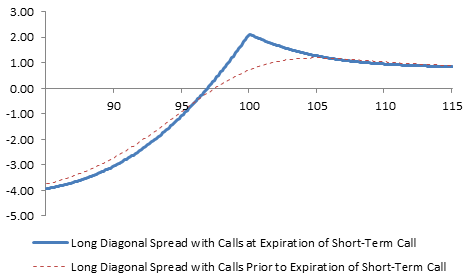LEAP Covered Writes (Diagonal Spreads)
Using LEAPs for covered call writing has its pros and cons. Let's examine.
What is a LEAP?
LEAP stands for Long-term Equity Anticipation Security. It is any option contract with an expiration date longer than 1 year.
What is a diagonal spread?
A diagonal spread is a pair of options that have the same underlying stock, same option type (call or put), but different strikes and expiration dates. You would short one option, and go long the other option to make a diagonal spread.
How would you use a LEAP for a covered write?
You would buy a LEAP call option (instead of shares of stock) and then sell a short-term call option on that same stock. While the combination of these two call options is a diagonal spread, it is also known as a LEAP covered write since the long call is a LEAP. Some investors call this trade the "poor man's covered call" because it behaves a bit like a covered call and can be entered into with less capital.
Example LEAP Covered Write
Let's say you buy a 2-month call with a 95-strike for $7.60 (that's $760 for 1 contract, but that's still less than buying 100 shares of stock) and then sell a 1-month call with 100-strike for $3.35. You now have a LEAP covered write (poor man's covered call).
| LEAP covered write |
| Buy 2-month call with 95-strike for 7.60 |
| Sell 1-month call with 100-strike for 3.35 |
If the 1-month option is exercised at 100 then you can either exercise your LEAP to deliver the shares, or you can sell the LEAP and buy shares on the open market to deliver.
If the 1-month option is not exercised then you can sell another short-term option against your LEAP for the next month.
In this example, your max loss (stock goes to zero) is 335 - 760 = -$425, and your max gain if assigned (stock over 100) is 10000 - 9500 + 335 - 760 = $75. Of course, if the 1-month option expires worthless (stock below 100) then the math changes as you sell another option for the next cycle. The goal is to have the stock stay flat, or at least not move too much, so you can sell a series of short-term options against your long term LEAP (which takes advantage of the typical option time decay pattern).
The blue line represents your profit after 1 month. It accounts for likely decay in the value of your LEAP after a month, plus resolution of the 1-month option. If the 100-strike option expires you can sell another one for the next month and the blue line will move up:

Selling Naked Options (Uncovered Writes)
Everyone knows that uncovered (naked) call writing is dangerous. If the underlying stock rises above the strike price then people who sold naked calls could face significant losses.
Covered Writes
The solution is to be "covered" when shorting call options. There are two ways to be covered:
- own the underlying stock, or
- own another call option (often a LEAP) for the underlying stock.
By doing one of those, you are covered if your short call option is assigned to you. You can either (1) deliver the shares you already own, or (2) exercise your LEAP and then surrender those shares to fulfill your obligation (or, sell your LEAP and buy shares in the open market to deliver).
Advantages of LEAP covered writes
- requires less capital than owning shares
- max loss is smaller than if you own shares
The reason less capital is required is because it costs less to buy 1 LEAP call option than it does to buy 100 shares of stock.
The reason 'max loss' is smaller is because the most you can lose is what you pay for the LEAP call option, whereas with stock the most you can lose is what you paid for the shares.
Disadvantages of LEAP covered writes
- you don't collect dividends (if the underlying is a dividend stock); if you're doing the LEAP over several quarters then you'll miss several dividends (compared to owning stock)
- your short option could be assigned, forcing you to exercise your LEAP prematurely thus forfeiting any remaining time premium and turning the trade into a loser; or, you could sell your LEAP and go into the open market to buy shares, but could still have an overall loss
- volatility could fall after the first short option expires, lowering the time value of your LEAP as well as future short-term options you would want to sell, making it harder (or impossible) to achieve your profit goal over several option cycles
- you may end up holding the LEAP across several high volatility events (earnings, product or FDA announcements, etc), any one of which could move the stock down dramatically; and, while the shares may recover eventually, the LEAP holder may run out of time as the LEAP's expiration clock is always ticking
- the bid-ask spreads on LEAPs are larger than on stocks so exiting the position will probably have more slippage than exiting a stock position
- you will need additional option trading approval from your broker in order to do spreads
- you may or may not be allowed to do diagonal spreads in a tax-deferred (i.e. IRA) account
Are Diagonal Spreads A Good Idea?
As with all strategies, there are some investors who find the risk/reward for a particular strategy (diagonal spreads or others) exactly meets their needs. But what is right for one investor may not be right for another. For investors who like to keep things simple and conservative, covered calls using stock is a better choice than any multi-legged pure option-based strategy (such as LEAP covered writes).
Mike Scanlin is the founder of Born To Sell and has been writing covered calls for a long time.
